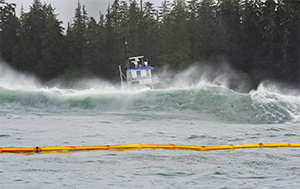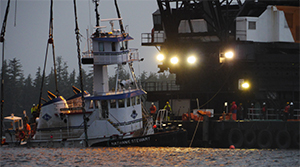After running aground at night near Bella Bella, British Columbia, the captain of an articulated tug-barge told the Canadian Coast Guard that the ATB was not in danger of sinking. But by daybreak the tugboat Nathan E. Stewart was taking on water and its fuel tanks had breached.
The twin-screw, 3,400-hp tug sank at about 0930 on Oct. 13, 2016, roughly 8.5 hours after grounding near Athlone Island at the entrance to Seaforth Channel. The empty tank barge DBL 55 also was damaged but remained afloat.
Nathan E. Stewart was carrying about 59,000 gallons of diesel and 2,500 gallons of lube and mechanical oils. Canadian authorities believe up to 25,000 gallons of fuel and 1,500 gallons of lube oils escaped from the tug, which remained aground for more than a month.
The spill fouled local waterways and coves considered sacred by the Heiltsuk Nation and reignited tensions around transporting oil through Canadian tribal areas.
The Transportation Safety Board of Canada (TSB) is leading the accident probe, although the U.S. Coast Guard and U.S. National Transportation Safety Board also are investigating. The tug and barge are owned by a subsidiary of Houston-based Kirby Corp.
Authorities from both countries declined to comment on a possible cause of the incident, citing the ongoing case. However, TSB senior investigator Glenn Budden said the ATB ran onto the rocks 200 meters from Athlone Island, suggesting the vessels failed to make the turn to port needed to enter the channel.
“From the AIS track for the previously roughly 50 minutes, it maintained the same speed and course until it hit the island,” Budden said in a recent interview.
Nathan E. Stewart and DBL 55 departed Ketchikan, Alaska, for Vancouver, B.C., at 2130 on Oct. 11. The vessels sailed south along the Inside Passage and planned to pass through Seaforth Channel. Local weather conditions recorded about an hour and 20 minutes after the grounding showed winds at 5 knots with 1-foot seas, according to the TSB.
The captain aboard Nathan E. Stewart was in regular radio contact with the Canadian Coast Guard after the grounding. He initially reported only the barge had grounded but later said the vessels spun with the tidal current and the tug also was aground.
The Canadian Coast Guard lifeboat Cape St. James traveled to the ATB’s location and offered Nathan E. Stewart a tow off the shoal. The tug’s captain gave an emphatic reply.
“No sir, I do not want to try and pull it off. I do not want to try and pull it off,” the officer said over the radio before adding “at the moment we are in no danger of sinking, we’re not taking on water at this time.”
 |
|
Waves push past a containment boom to batter the grounded Nathan E. Stewart near Athlone Island. The tug spilled up to 25,000 gallons of fuel. |
|
Courtesy Heiltsuk Nation |
Low tide occurred at about 0530 that morning. At about the same time, Nathan E. Stewart’s crew reported flooding of about a gallon per minute. The crew also identified a breach in a port fuel tank and potential breaches in other tanks. They began pumping diesel from the fuel tanks into the barge but recognized time was running out.
“We had a complete valve failure in the engine room of our one starboard tank, and as a result our bilge is filling with fuel,” the tug captain announced over radio. “We also had a another breach on the starboard-side bulkhead, we’re taking on more water, the levels in the engine room are coming up to the generator, and we won’t be here long. We’re going to lose power.”
Nathan E. Stewart’s seven-person crew evacuated the tug shortly before it sank stern-first with its towing pins still connected to the barge. Eventually the pins gave way and the tug settled on the bottom in about 28 feet of water, leaving only its mast exposed. DBL 55 was recovered and later towed to Vancouver.
“There was definitely some damage to the bottom of the barge, but there was very little if any pollution from the barge,” Budden said. “It was empty at the time, and thank God for that.”
After the incident, Canadian authorities established a unified command that involved dozens of vessels, several support aircraft and hundreds of people. Crews laid boom around the tug and much of the barge before it was removed to contain remaining fuel, and at least three skimmers patrolled around the tug. Crews also filled hundreds of bags with oil-absorbent pads.
Salvage crews pumped about 110,000 liters of oil-water mixture from the tug, and oil response skimmers removed some diesel from the water. The fuel created only a thin sheen on the surface, making removal a challenge.
Flight crews spotted an oily sheen in waters around the grounded tug for weeks following the incident. The Heiltsuk Nation said oil reached at least three of its coves and fouled its historical fishing areas.
Resolve Marine Group was hired to salvage the tug. The operation was repeatedly delayed by high winds and high waves that hampered responders for weeks. Crews eventually were able to shift the vessel to deeper water, then used a crane to lift it onto a transport barge. The salvage finished on Nov. 14 and the tug was towed to a shoreside facility in Surrey, B.C. Resolve did not respond to requests for more information about the project.
Investigators viewed Nathan E. Stewart from afar on Nov. 19 and then took photos and video aboard the tug two days later, Budden said. Authorities have interviewed the crew and tested for drugs and alcohol, although the results of those inquiries were not released.
Kirby Corp. issued a statement saying it was cooperating with the U.S. and Canadian investigations but declined further comment.

